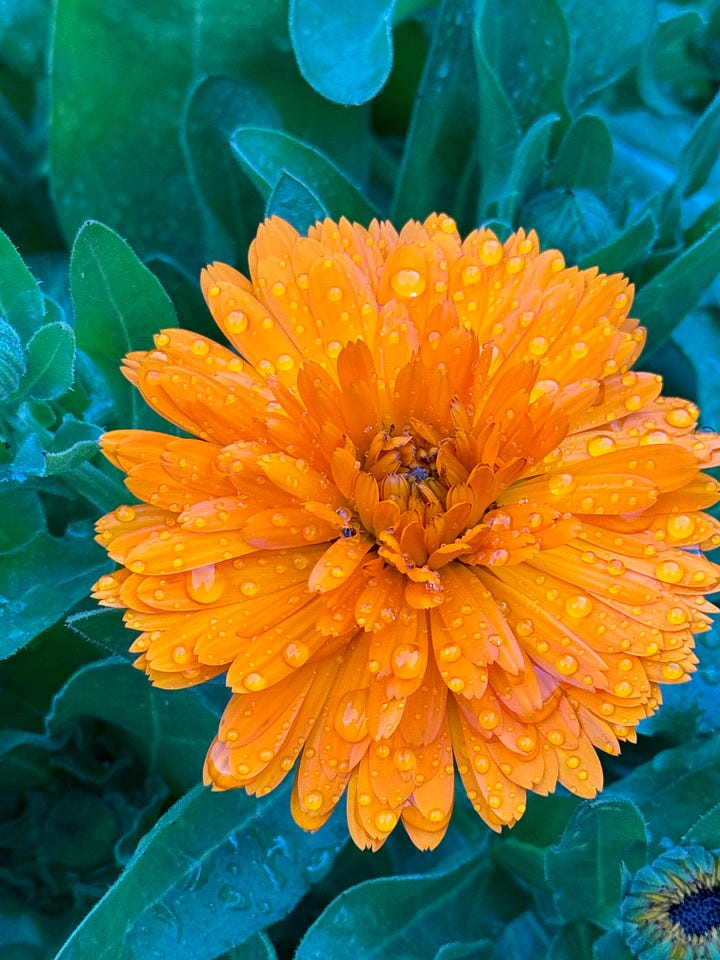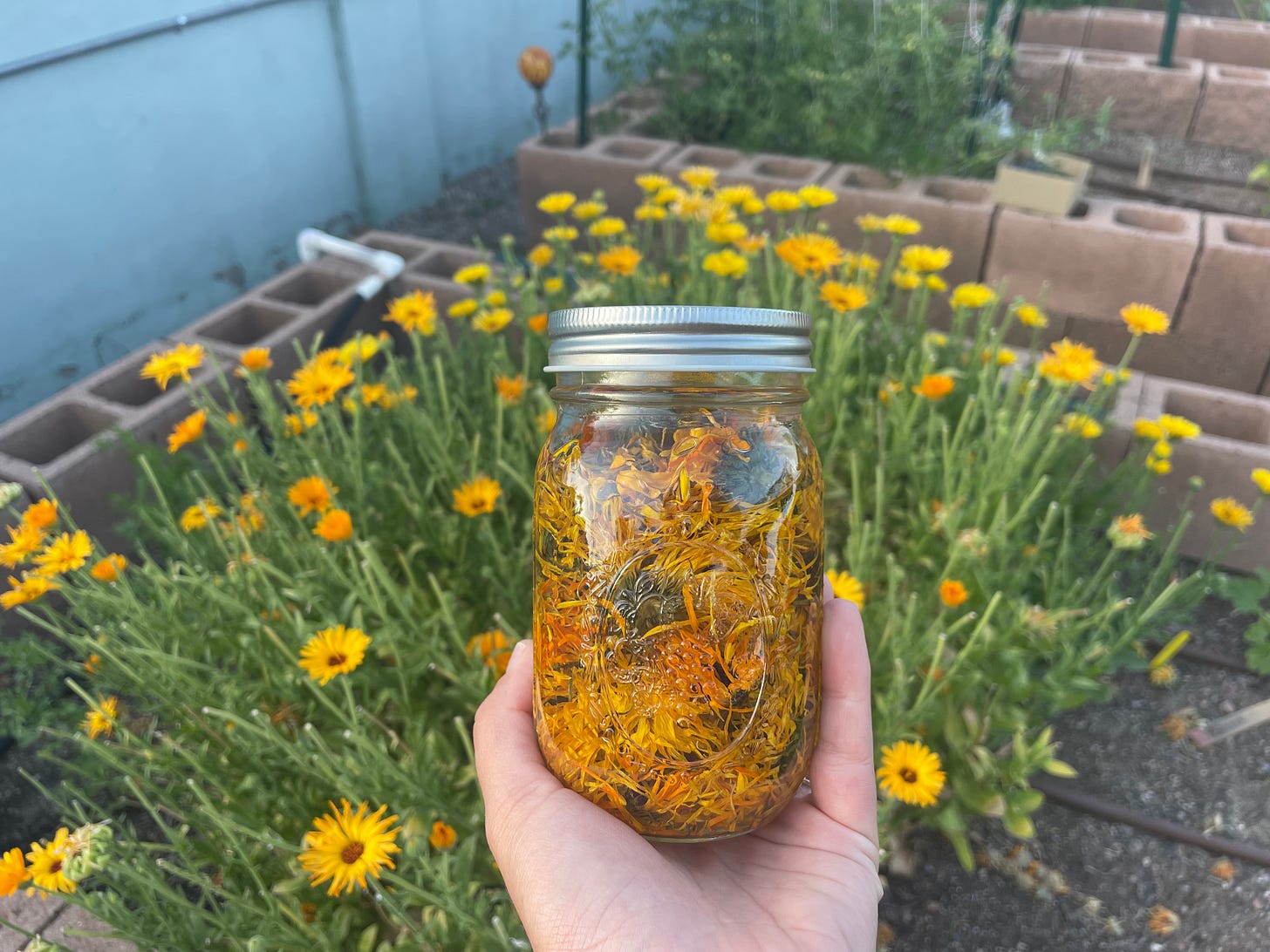Calendula: Seasonal Ingredient Spotlight
How to harvest, medicinal properties, and recipes on using the dried flowers
It’s beginning to be the time of year when the sun begins to rise earlier and earlier. I’ve come to really enjoy early spring and summer mornings when the birds are chirping, the world is still, and the air is still cool.
Every morning I make an effort to step outside into the morning sunlight, barefoot, making my rounds through our garden. I check for new sprouts, flowers on our vegetable plants, and weeds breaking through the soil.


While I am beginning to harvest beans, tomatoes, and the last of our beets, my main chore remains tending to our calendula. Each day, I “deadhead” the calendula plants, cutting off the flowers that are beginning to weather away, making room for new growth. This has allowed the plants to blossom in size, with one plant taking over a third of the bed it’s planted in.
What have I been doing with the beautifully blooming calendula flowers? Well, you’ll have to keep reading to find out.
Medicinal properties of Calendula
Before I expand on how I’ve been using the calendula, many people would be surprised to find that calendula is quite medicinal. While gardeners typically know it for its intoxicating scent that lures bugs away from other crops, herbalists know it for its soothing properties.
When applied externally, Calendula extract has been shown to speed the healing process of wounds, helping to calm the inflammation from injuries such as burns. Some research shows that the plant grew in popularity during the Civil War to help stop soldiers’ wounds from bleeding out.
When ingested, it has been shown to exhibit antimicrobial, antibacterial, anti-tumor, and anti-inflammatory properties. In fact, Calendula was frequently used in ancient forms of medicine such as Ayurveda and homeopathy for these various reasons.
Naturally, I want to take advantage of all the flowers’ medicinal properties while it’s growing in my garden.
Harvesting and drying Calendula
Calendula should be harvested in the morning, when the petals are half open. This is when the oils are the most concentrated.
After harvesting the heads, I lay them flat in the dehydrator and dehydrate them for 10 hours at a temperature of 165 degrees Fahrenheit.
After, I store them in an air-tight jar to be used however I wish throughout the season.
I love growing and drying medicinal herbs and flowers myself, because I know exactly where they came from. I’m not depending on a supplier to tell me whether they were organic or not. I can see the quality of the flowers and their oils with my own eyes.


How to use dried Calendula
Once you dry out the Calendula flowers, you can begin to use them both externally and internally.
Anti-inflammatory spring tea
My favorite way to ingest Calendula is by turning it into a tea. The taste is very subtle, so it goes well with just about everything. However, I’ve been enjoying making a spring allergy tea using the Calendula, Nettle, and Oatstraw.
Nettle and Oatstraw are high in minerals and help with seasonal allergies. The calendula not only looks beautiful in the tea, but helps to calm inflammation that comes with allergies.
Recipe:
3 tsp Nettle
3 tsp Oatstraw
5-8 dried Calendula flowers
Put your ingredients into a larger mason jar, 20-30oz or so. Pour boiling water into the jar and top with the lid. Let sit for a few hours and then put in the fridge to cool. Strain as you enjoy over the next few days.
Infused oil
As I mentioned, Calendula is wonderful for any types of skin issues. Infusing oils with the flowers will help to extract the healing oils on the Calendula flowers. I like to use jojoba or sweet almond oil.
Lately, I’ve been applying this oil to a rash that’s been popping up on my neck. It is incredibly healing and soothing to the rash. I’ve also seen people then use this oil to make homemade lip balms!
Recipe:
Calendula flowers
Oil of choice
Air-tight jar
Fill your jar with flowers- all the way to the top! Pour your oil over the flowers, completely covering them with the oil. Seal the jar shut and hide away somewhere dark for 4-6 weeks.
After the time has passed, strain the flowers from the jar and use as you wish. You can apply it straight to your skin or use it in other body care recipes!
Take action
Are you using lotions with fragrance or inflammatory oils such as grapeseed and sunflower oil? Maybe it’s time to replace these with a new product that you can feel good about putting on your skin.
Replace this with some Calendula oil, or a product made using the oil such as lotion or salve. Better yet, if you’re feeling ambitious, purchase some dried calendula and oil and make your own oil! And if you are a gardener like me, maybe try growing some this season.
What seasonal ingredient should I highlight next? Leave a comment below!
Have a great Sunday!
Madison





How about rosemary? In combination with different oils and other herbs 🌿 to produce a home-made SPF50 sunscreen naturally!🧴